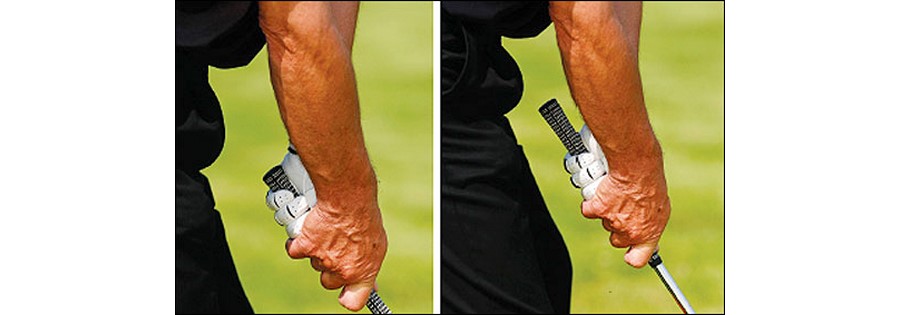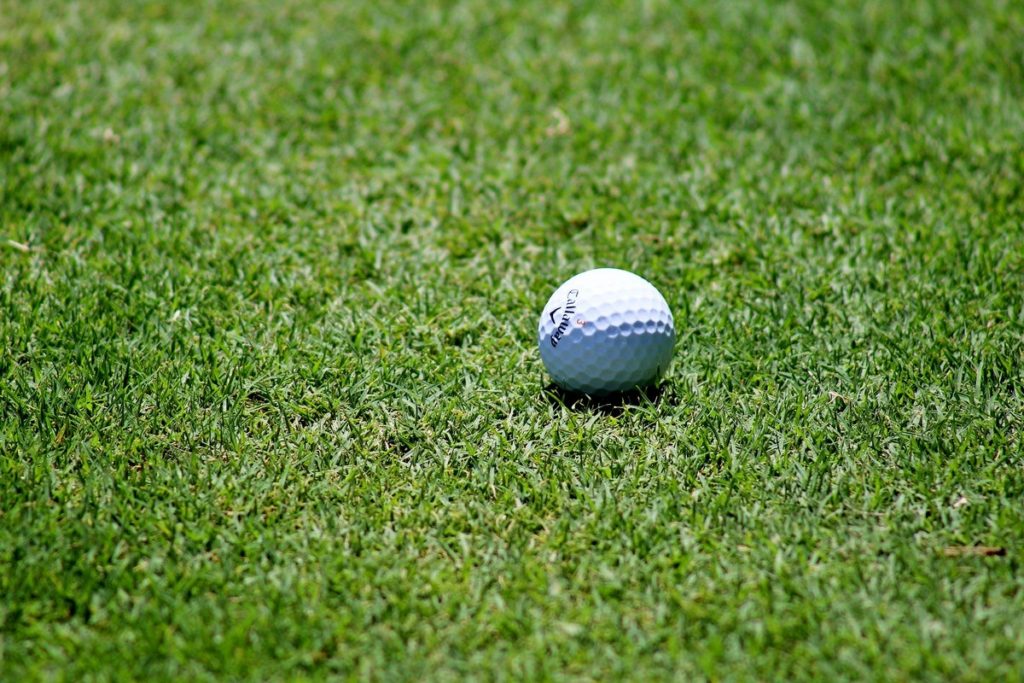Whatever your current level of play, saving shots in the short game is the quickest route to shooting consistently lower scores. And in terms of learning new skills, it’s also the easiest. So let me share with you some of the thoughts that I believe you need to learn to develop a basic pitching technique – one that will reward you with the ability to influence the trajectory of the ball and thus expand your repertoire with a wide variety of shots
By Pete Cowen
Shoulder turn controls arms/hands & club
From a practical point of view, the theme to the lessons I am about to share with you here is that the role of the upper body is vital in the process of creating a repeating method.
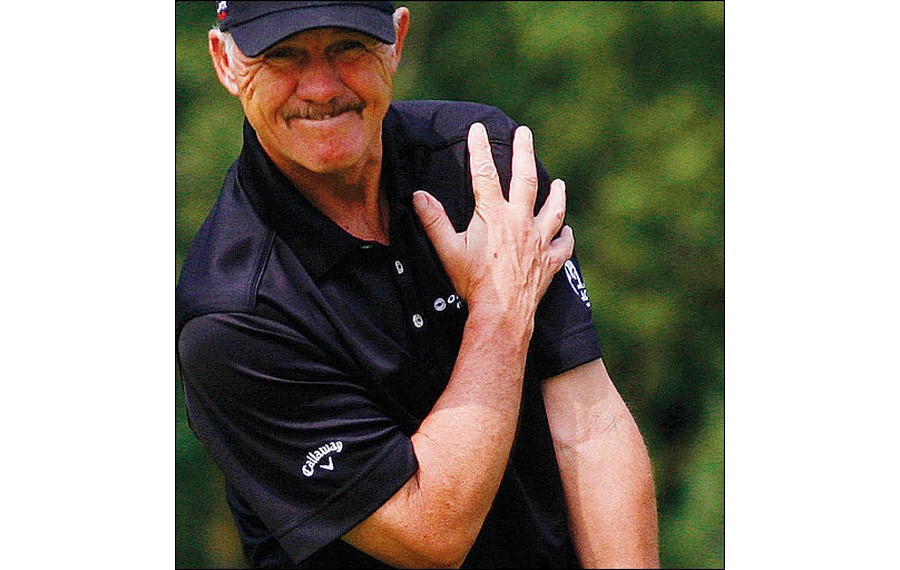
The cardinal error is to rely too much on hand action (as per the insets below you see here showing two of the most common faults in this department of the game). Watch good chippers and pitchers of the ball and you will see that the momentum of their action is controlled by the turning motion of the upper body – that is the secret to the consistent behaviour of the arms, hands and – ultimately – the club. And as the upper body keeps on turning, so the left shoulder works up and around to the finish. For me, that’s key.
So, let’s get to work and look first at a simple drill that will set you on the way to experiencing the sensation of a bodycontrolled pitching technique. The rewards will be worth it, believe me.
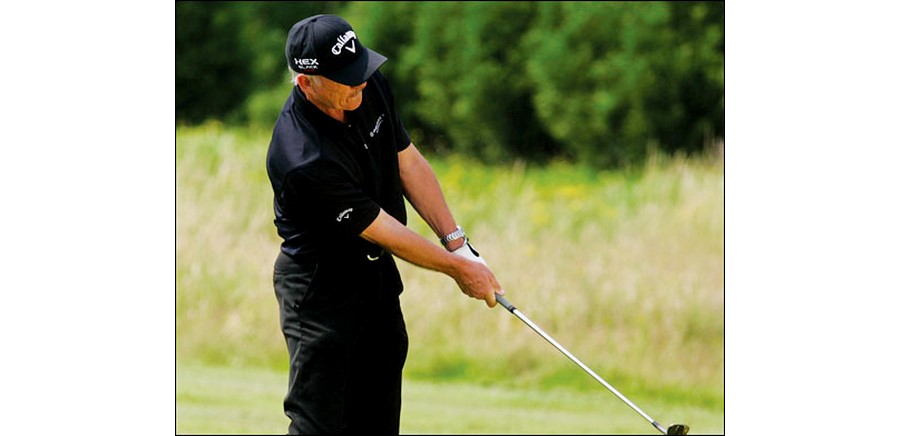
Signs of a breakdown
Poor chippers and pitchers of the ball tend to rely too much on their hand action through the hitting area. They fail to grasp the vital sequence of motion – i.e. the controlling influence of the body – and over-use the hands. Higher handicap golfers are prone to flicking at the ball with a wristy motion (below left), while in the case of the better player you often see the hands driving forward through impact, delofting the clubface (right). Both of these faults create imbalance in the swing, and kill any versatility around the green.

Balance the motion of club & body
Whenever I get asked for the ‘secret’ to a good pitching action, I point golfers in the direction of this wonderfully effective exercise – one that quickly rewards you with the sensation of upper body control that is vital to enjoying a consistent strike in this all-important aspect of the game.
To start, simply get yourself into a comfortable set-up, your feet fairly close together, left toe turned out slightly, and weight just favouring your left side. Then take your right hand off the grip and place it on your left shoulder. In so doing, you are immediately be made aware of a heightened sensation of left side control. Your left hand has a comfortable (i.e. not too tight) hold on the grip, while placing your right hand on the left shoulder simply raises your awareness of that area of the upper body.


Now go ahead and make a simple swing, your focus being on controlling the motion with the turning of the left shoulder – you want to feel that your right hand pulls the left shoulder down and around into the backswing, setting off a chain reaction as the arm and hand respond, the left wrist cocking gently in response to the weight of the clubhead.
The real beauty of this exercise is felt on the way back down to the ball and through impact. With your right hand now encouraging the (re-) rotation of the left shoulder, you want to feel your upper body paces the return journey, your left arm/hand following this momentum, the left wrist uncocking naturally and the clubhead collecting the ball in the process. There is no manipulation whatsoever in the strike. It is neutral as the left arm and body work in unison. As it was at the set-up, the shaft is seen to be leaning toward the target at impact, but – most important of all – it is working up on its way to the finish.
Supported by a subtle knee and leg action, the upper body is turning through and left (of the target line), clearing the way for the uninhibited strike on the ball and the release to a controlled finish.
Regular repetition of this exercise will transform your feeling for a sound chipping action and help to establish a real understanding of the controlling role of the upper body. All positive so far.
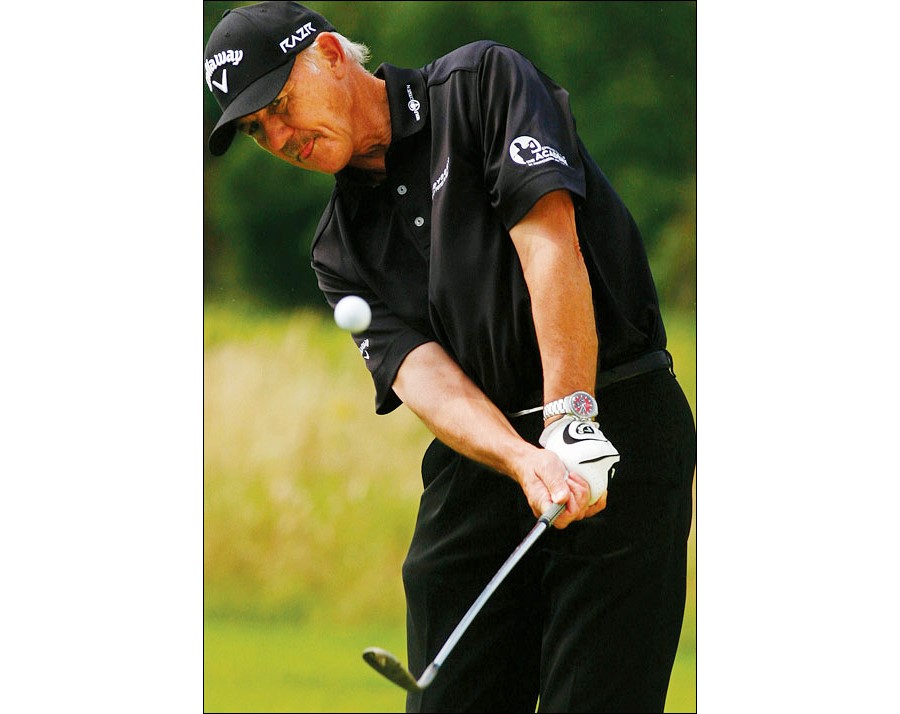
Body language says it all; going in low, or floating it in high
As your confidence grows in the pitching arena so you can build on the basics of good technique and extend your repertoire of shots. And the single most important lesson here is that your set-up must always reflect what you intend to do with the ball.
When you need a lower, running type of shot (sequence above), you move the ball back a fraction, lean the clubshaft gently toward the target (delofting the face a fraction as your hands ease ahead of the ball) and build your stance accordingly. The swing follows on logically from there, your weight just favouring the left side throughout, and the low shot is always characterised by a fairly low finish.
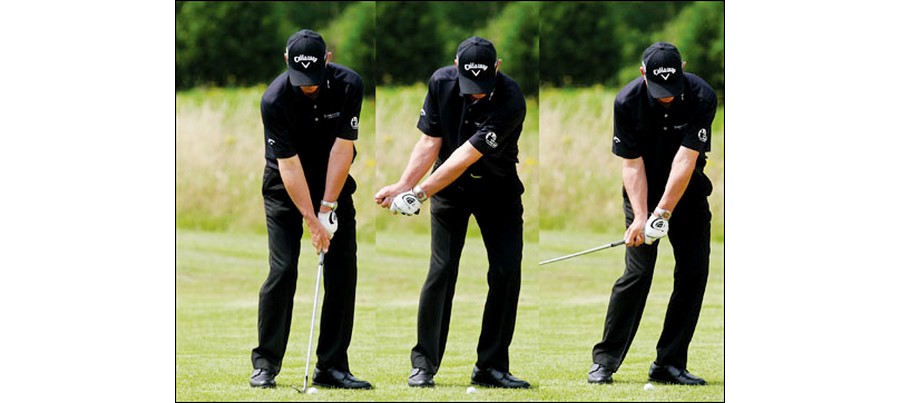
(C) Left shoulder works down, left arm swings across the chest to create controlled backswing, hands relatively passive
(R) Weight rotates into the left side as the upper body controls the delivery of the arms and club
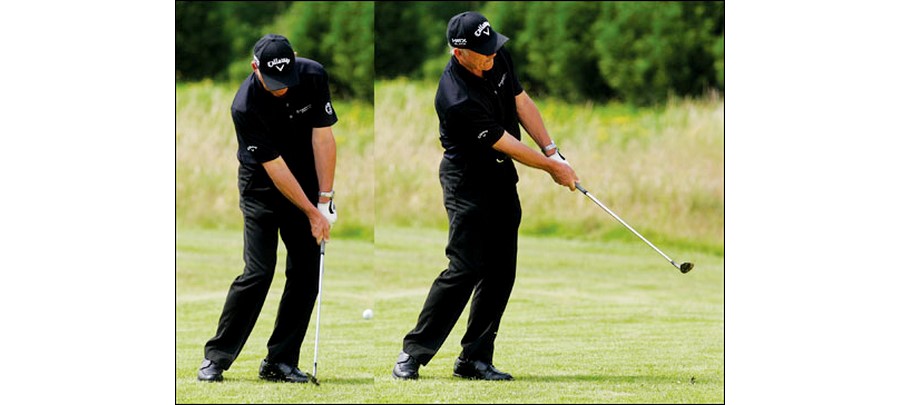
(R) Lower shots are characterised by a shorter follow-through. Hold the balance
Need to maximise loft? The adjustments are as you would expect: play the ball a little further forward in the stance, lean the shaft away from the target a little, and let your body take its order from the position of the clubface as you then settle into the shot. A higher, floating shot requires more clubhead speed, so you need to extend the length of your swing and this naturally results in a fuller finish as you release the speed to a finish.

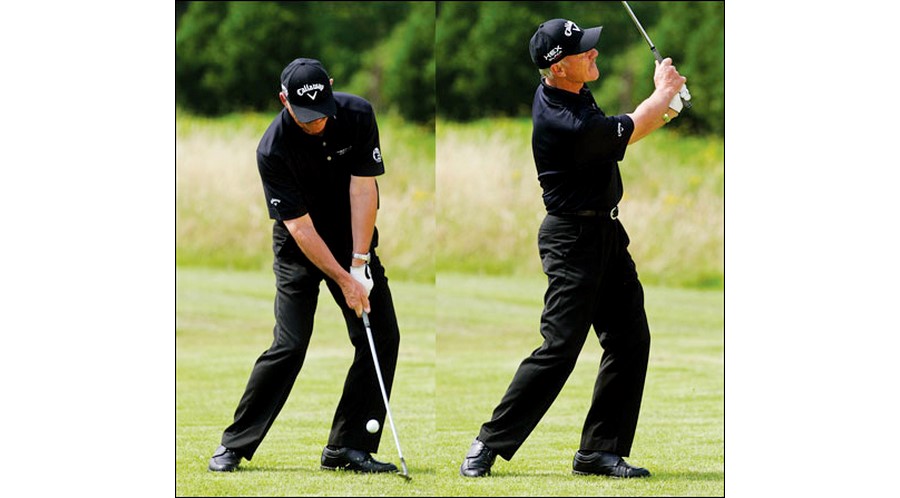
(R) The higher the shot, the fuller the finish – note the way the left shoulder has rotated out of the way to allow the right side to turn through
Great exponents of the short game like to ‘set’ and then maintain the angle between their right hand and the shaft. Bear that in mind as you go to work on these skills. Control the flight of the ball with the set up position, the length of your swing and the way you visualise the shot, which gives your body the message.
How to cultivate correct wrist hinge
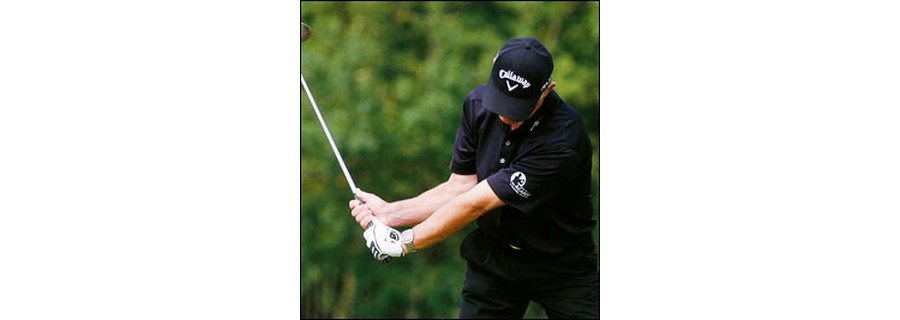
Splitting your hands apart on the grip, as you see illustrated here, is a great way to appreciate the sensation of the hands/wrists working and hingeing correctly in order to maintain loft on the clubface in the short game. I’d recommend you spending a couple of minutes during each practice session rehearsing this, even hitting balls with this grip, as it will quickly teach you to recognise the feeling of a good hand and wrist action. The better you get at ‘cranking’ the wrists in the backswing, the more loft you will return to the ball through impact (and that same wrist action will improve your ball striking in the long game, too)
Distance control: A factor of swing length & rhythm
With the emphasis again on the quality of your body rotation, I want to leave you with a couple of simple ideas that will help you to govern the pace and rhythm of your swing and, with it, finetune distance control.
The blended backswing and through-swing positions you see above illustrate the method used by the majority of tour players when it comes to controlling distance in the pitching arena; a ‘clockface’ principle that involves matching body rotation and length of arm swing on either side of the ball to identify with your ‘best’ (i.e. most consistent) landing distances using the lofted scoring clubs.
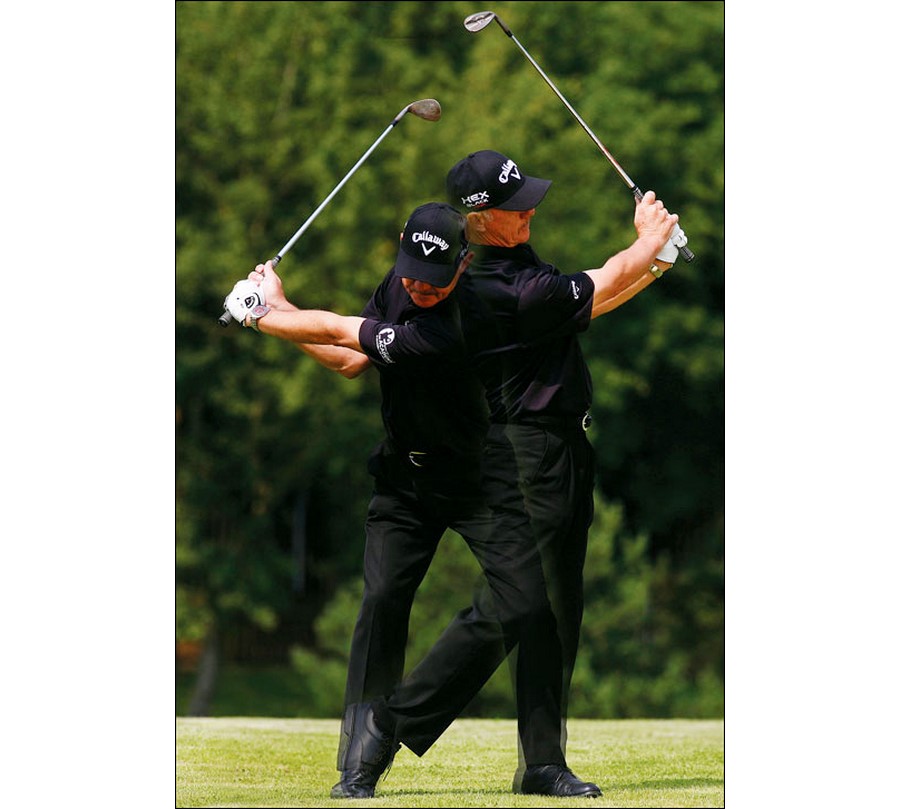
Once you grasp the concept it’s all about investing the hours out on the range to hone your feel and establish exact landing distances with your favourite wedges. So, for example, a 9 o’clock to 3 o’clock ‘half’ swing (above left) sees the rotation of the upper body take the arms and hands to approximately 9 on the clockface in the backswing, through to a little after 3 on the way through. That’s a controlled half swing – perfect in the wedge game. Hit balls with all of your scoring clubs – PW, Gap and Sand Wedge – and find out exactly how far you land the ball repeating this controlled swing.

Then take it a stage further, adding a beat to your rhythm to extend your swing to what is essentially a full swing with a wedge – 11 o’clock to 1 o’clock (above right). The shoulders turn that little bit further, the arms swing that little bit fuller. Again, meaasure your landing distances – that’s vital information.
